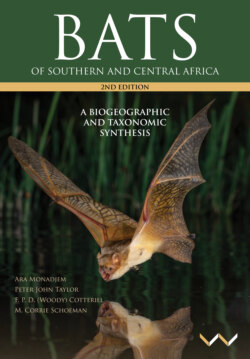Читать книгу Bats of Southern and Central Africa - Ara Monadjem - Страница 41
На сайте Литреса книга снята с продажи.
Savanna
ОглавлениеThe savanna biome is characterised by widely spaced trees that form an open canopy, allowing sufficient light to reach the ground to support an unbroken herbaceous layer consisting primarily of grasses. This biome originated in the early Neogene (de la Estrella et al. 2017) and expanded in the Late Miocene (∼7 Ma) (Bouchenak-Khelladi and Hodkinson 2011). Much of the southern African region is covered by such savanna woodlands, which support the greatest species richness of bats (Gelderblom et al. 1995, Schoeman et al. 2013). Second only to rodents, bats are also one of the most species-rich groups of mammals occurring in the southern savanna biome (Grubb 1999).
Miombo woodlands – the world’s most extensive dry forests – cover a large portion of southern Africa north and east of the 600 m annual rainfall isohyet.
Miombo occurs from Angola in the west across Katanga (DRC), Zambia and Malawi to Tanzania, most of Mozambique, and much of Zimbabwe (Frost 1996). The southern limit of miombo just reaches South Africa near the Luvuvhu River and on the Soutpansberg massif. Bat species encountered in mesic miombo include the molossid Mops niveiventer and the vespers Mimetillus thomasi and Scotoecus hindei/albigula. The southernmost limits of many Congo basin vertebrate species are associated with gallery forests that penetrate mesic miombo woodlands (Cotterill 2002a, b). These include the fruit bats Myonycteris angolensis and M. torquata.
There are also extensive miombo woodlands on deep Kalahari sands in the western regions of Zambia, eastern Angola and the southern DRC. Although much of the southern portion of this belt receives rainfall characteristic of semi-arid savannas, these tall woodlands depend on groundwater in deep Kalahari sediments. This edaphic control on the vegetation is exemplified in the Cryptosepalum evergreen forests (Mavunda) on Kalahari sediments in western Zambia and eastern Angola (White 1983), and equally in the hardwood Zambezi teak forests dominated by Baikiaea plurijuga, with their distribution centred on the Four Corners Region (Huckaby 1986, Frost 1996).
Mopane woodlands, dominated by the emergent Colophospermum mopane, are associated with particular soil formations, largely on alluvium at lower altitudes throughout the middle and lowveld of Zimbabwe, and also in large parts of southern Zambia, central and southern Mozambique, northern South Africa, northern and eastern Botswana, as well as northern Namibia and southwestern Angola (Cole 1986). Mopane woodlands are of singular significance to bat biogeography, because the hollows in mature trees, the aptly named cathedral mopane, offer plentiful roosting sites for bats. Woodland degradation, whether by elephants or humans (e.g. wholesale clearing for cotton plantations in northwestern Zimbabwe), destroys the larger trees and has highly negative effects on the abundance and species richness of bat assemblages (Fenton et al. 1998a, McCleery et al. 2018) (Figure 32).
Thorny acacia (genera Vachellia and Senegalia) savannas dominate large parts of southern Zimbabwe, northern South Africa, Botswana and Namibia, extending into the Kalahari. Cavities in these large trees, and cavities under bark, support tree-roosting bats.
The community structure of savanna bat assemblages arises from abiotic and biotic processes operating at local and regional scales (Schoeman and Monadjem 2018). At a regional scale, speciation mediated by historic geomorphic and climatic events has shaped the bat diversity of the regional species pool. The high taxonomic and phylogenetic bat diversity in the savanna biome is maintained by the stable wet and warm climate and high habitat heterogeneity. Processes at the mesoscale probably play a minor role because the high mobility of bats enables them to select habitat patches even in human-dominated urban and agricultural landscapes. Multiple biotic processes, including competition and prey defences, operate at a local scale, but non-random patterns are not ubiquitous within and across ecomorphological variables (Schoeman and Jacobs 2008, 2011).
